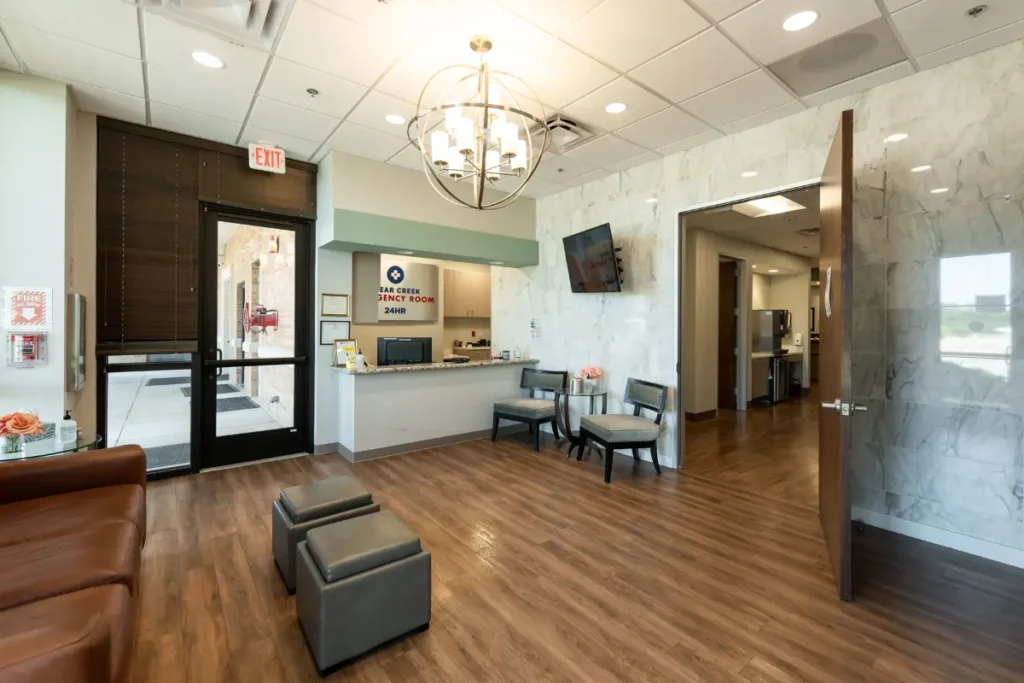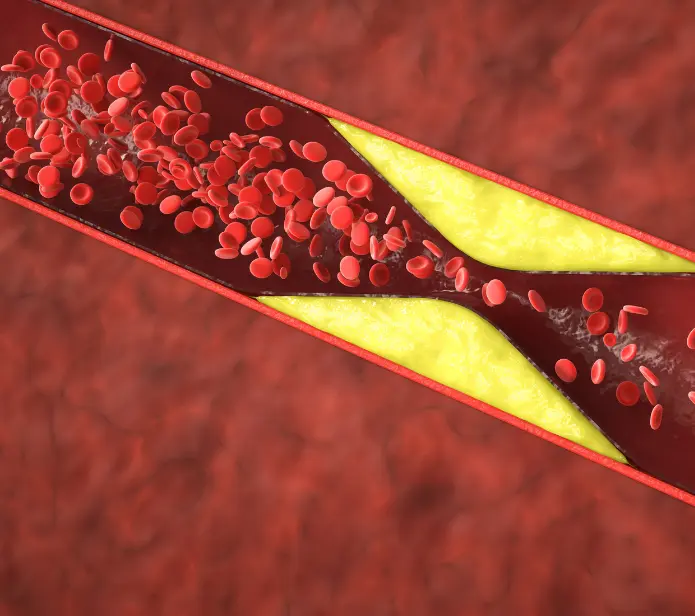Emergency Room for Blood Clot Treatment in Houston, TX
When time is critical, trust Village Emergency Centers to provide swift, expert care for blood clots. Our medical team is equipped with the latest diagnostic tools to address this life-threatening condition and ensure timely intervention. Whether you need urgent care for a blood clot or pain relief for pulmonary embolism, we are here 24/7 to deliver the care you need, when you need it most.


Why Choose Us?
Why is Houston Community Choosing Village Emergency Center for Blood Clot Treatment?
Village Emergency Centers are renowned for providing immediate, specialized care for blood clot emergencies. Our board-certified doctors, advanced technology, and dedication to patient care make us the top choice for urgent blood clot treatment in Houston. We understand the urgency of this condition and act fast to safeguard your health.
What Is a Blood Clot?
A blood clot, also known as a thrombus, is a gel-like mass that forms when blood cells stick together and clump. This process, known as coagulation, typically occurs within the veins or arteries. If left untreated, blood clots can potentially be harmful, as they can obstruct blood flow to vital organs such as the heart, lungs, or brain, leading to severe complications. Awareness of the risk factors and symptoms associated with blood clots is important, as early detection and intervention can be crucial in preventing serious health issues.
Arterial Thrombosis
Arterial blood clots in the arteries can lead to serious conditions such as heart attacks or strokes. They are usually caused by a buildup of plaque or fatty deposits in the arteries, which can restrict blood flow. In some cases, arterial clots can also form due to physical injury or trauma.
Venous Thrombosis
Venous blood clots occur in the veins and are commonly known as deep vein thrombosis (DVT). They typically form in the legs or pelvis and can cause pain, swelling, and potentially life-threatening complications if they break loose and travel to the lungs (pulmonary embolism).
Superficial Vein Thrombosis
Superficial Vein Thrombosis (SVT) is a condition where a blood clot forms in a superficial vein, usually near the surface of the skin. Although SVT is generally not as serious as Deep Vein Thrombosis (DVT), it can still cause pain, swelling, and redness in the affected area. Treatment for SVT often involves pain relief and the use of compression stockings to reduce symptoms and prevent complications.
Deep Vein Thrombosis
Deep Vein Thrombosis (DVT) is a potentially life-threatening condition where a blood clot forms in a deep vein, most commonly in the leg. DVT can lead to serious complications if the blood clot breaks loose and travels to the lungs, causing a pulmonary embolism. Symptoms of DVT may include leg pain, swelling, warmth, and redness. Treatment for DVT typically involves the use of blood thinners to prevent further clot formation and reduce the risk of complications.

What Causes Blood Clots?
Blood clots can be caused by a variety of factors, including:
Inherited Blood Clotting Disorders: Some people are born with abnormal blood clotting genes, which can increase their risk of developing a blood clot.
Prolonged immobility: Sitting or standing for prolonged periods, such as on long flights or bed rest after surgery, can slow down blood flow and increase the risk of clot formation.
Cancer and cancer treatment: Certain cancers, as well as treatments like chemotherapy, can increase the risk of blood clots.
Pregnancy: The hormonal changes during pregnancy can increase the likelihood of developing a blood clot.
Obesity: Being overweight or obese puts extra pressure on the veins and can lead to slower blood flow, increasing the risk of blood clots.
Smoking: Smoking damages the lining of the blood vessels, making them more prone to clot formation.
Medications: Certain medications like birth control pills and hormone replacement therapy can increase the risk of blood clots in some individuals.
What Does a Blood Clot Feel Like?
The sensations associated with a blood clot can vary greatly depending on its size and location. In some situations, blood clots may cause no symptoms or signs and remain undetected until they cause complications. However, when symptoms do occur, they can include:
– Persistent throbbing or cramp-like pain
– Warmth and redness over the site of the clot
Swelling
– Acute pain and swelling in the affected limb (if the clot is in a leg or an arm)
– Heavy or weak feeling in the limb
In other cases, such as when a blood clot is present in the lung (pulmonary embolism), symptoms may include:
– Sudden and unexplained shortness of breath
– Sharp chest pain that may worsen with deep breathing
– Lightheadedness
– Rapid pulse
– Coughing up blood
If you experience any of these symptoms, it is important to seek medical attention immediately.

Blood Clot Symptoms
The symptoms of blood clots can vary depending on their location in the body. Here are some common symptoms associated with blood clots:
Deep Vein Thrombosis (DVT)
This condition often presents symptoms such as swelling, discomfort or pain, a warm sensation, and red or discolored skin in the affected limb.
Pulmonary Embolism (PE)
Symptoms include sudden shortness of breath, chest pain that may worsen with deep breaths, a rapid heartbeat, lightheadedness or fainting, and coughing up blood.
Superficial Venous Thrombosis (SVT)
Symptoms typically involve localized pain and redness along the vein.
Arterial Clots
The symptoms can include severe pain, paleness, coldness in the extremities, loss of muscle function, or a decrease or absence of pulse.
Cerebral Venous Thrombosis (CVT)
This condition may have symptoms like headaches, blurry vision, fainting, loss of balance or coordination, difficulty speaking, and seizures.
How to Check for a Blood Clot in Your Leg
To check for a blood clot in your leg, there are several signs and symptoms to be aware of:
Pain or Tenderness
Some people with a deep vein clot experience pain or tenderness in the affected leg, especially when standing or walking.
Warmth
The skin over the affected area may feel warm to the touch. This is due to increased blood flow caused by the clot.
Swelling
This is often the primary symptom of a deep vein blood clot. It usually occurs in one leg and may come on suddenly or gradually increase over several days.
Red or Discolored Skin
The skin on the leg may turn red or blue, signaling a possible clot.
Hard Vein
Sometimes, the vein may feel hard instead of soft when you touch it.
How to Prevent Blood Clots
There are several steps you can take to reduce your risk of developing a blood clot:
– Stay active: Regular exercise helps keep the blood flowing and reduces the risk of blood clots.
– Maintain a healthy weight: Being overweight or obese increases the risk of blood clot formation.
– Quit smoking: Smoking damages the lining of the blood vessels, making them more prone to clot formation.
– Avoid prolonged periods of sitting or standing: If you are on a long flight or have a sedentary job, remember to get up and move around at regular intervals.
– Stay hydrated: Drinking plenty of water helps prevent dehydration, which can contribute to blood clot formation.
– Follow your doctor’s recommendations: If you have any underlying health conditions or are at a higher risk of developing blood clots, your doctor may recommend specific precautions or medications to prevent them.
When to Go to the Emergency Room For Blood Clot Urgent Care?
If you experience any symptoms of a blood clot, such as sudden shortness of breath, chest pain, or swelling in the legs, seek emergency medical care immediately. Blood clots can be life-threatening and require immediate treatment to prevent serious complications.
Visit One of Our Locations Throughout Houston
If you have any concerns about blood clots or pulmonary embolisms, trust Village Emergency Centers for expert treatment and care. Our team of experienced medical professionals is available 24/7 to provide timely, compassionate, and effective treatment for all types of blood clots. We utilize advanced diagnostic tools such as Ultrasound, X-Ray, and CT Scan to ensure accurate diagnosis and effective care. Whether your concerns involve Women’s Health or other conditions, don’t wait – seek help immediately if you suspect a blood clot.
FAQs About Blood Clot

What Our Patients are Saying About Our Emergency Care Services
Amy Trim
League City
“This emergency room is absolute AMAZING. Both my husband & I have been treated here & have had phenomenal experiences. They always treat you with love & respect. They run all of the tests that are needed, but they don’t add a bunch of unnecessary test. We all know that doctors are human, but sometimes I think some doctors forget that but not at Clear Creek Emergency Room. Dr. Luna, Dr. Cruz, and Rommel, RN are amazing!”
Keyla H
Clear Creek
“I recently had an experience at the Clear Creek Emergency Room that exceeded my expectations. The staff was incredibly fast and efficient, ensuring that I received the care I needed without unnecessary delays. I was particularly impressed by great bedside manner of Doctor Cruz and highly skilled nurse Rommel who attended to me. I truly appreciate the dedication and efficiency of the entire team. Thank you for providing such exceptional care!”
Isela Luna
Jersey Village
“I was pleased to know there’s a place to get urgent care when needed. I was taken care off promptly and efficiently. Dr. Luna treated me with respect and was very informative about my health condition. I actually was in and out of there in 3 hours. Everything was explained to me and I am happy to know there’s a place like this Jersey Village ER. Hopefully, I will not need to return but if I need to I know I will get great care. Thank you Dr Luna and staff.”

